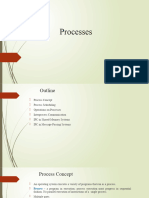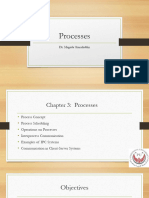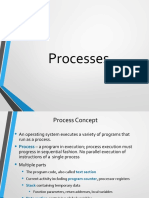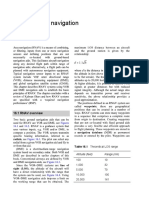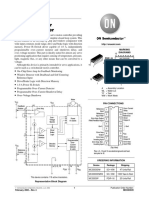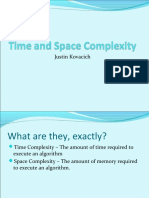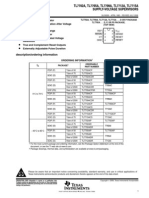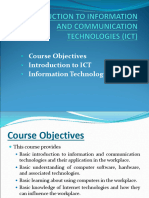Unit - II
Co-operating Processes
Process Concept
● An operating system executes a variety of programs:
● Batch system – jobs
● Time-shared systems – user programs or tasks
● Textbook uses the terms job and process almost interchangeably
● Process – a program in execution; process execution must progress in sequential fashion
● A process includes:
● program counter
● stack
● data section
The Process
● Multiple parts
● The program code, also called text section
● Current activity including program counter, processor
registers
● Stack containing temporary data
4 Function parameters, return addresses, local variables
● Data section containing global variables
● Heap containing memory dynamically allocated during run
time
● Program is passive entity, process is active
● Program becomes process when executable file loaded into
memory
● Execution of program started via GUI mouse clicks, command
line entry of its name, etc
Process in Memory
Process State
● As a process executes, it changes state
● new: The process is being created
● running: Instructions are being executed
● waiting: The process is waiting for some event to
occur
● ready: The process is waiting to be assigned to a
processor
● terminated: The process has finished execution
Diagram of Process State
Process Control Block (PCB)
Information associated with each process
● Process state
● Program counter
● CPU registers
● CPU scheduling information
● Memory-management information
● Accounting information
● I/O status information
Process Control Block (PCB)
CPU Switch From Process to Process
Process Scheduling
● Maximize CPU use, quickly switch processes onto CPU
for time sharing
● Process scheduler selects among available
processes for next execution on CPU
● Maintains scheduling queues of processes
● Job queue – set of all processes in the system
● Ready queue – set of all processes residing in
main memory, ready and waiting to execute
● Device queues – set of processes waiting for an
I/O device
● Processes migrate among the various queues
Process Representation in Linux
● Represented by the C structure task_struct
pid t pid; /* process identifier */
long state; /* state of the process */
unsigned int time slice /* scheduling information */ struct task struct *parent; /*
this process’s parent */ struct list head children; /* this process’s children */
struct files struct *files; /* list of open files */ struct mm struct *mm; /*
address space of this pro */
Ready Queue And Various
I/O Device Queues
Representation of Process Scheduling
Schedulers
● Long-term scheduler (or job scheduler) – selects which processes should be brought
into the ready queue
● Short-term scheduler (or CPU scheduler) – selects which process should be
executed next and allocates CPU
● Sometimes the only scheduler in a system
Schedulers (Cont.)
● Short-term scheduler is invoked very frequently
(milliseconds) ⇒ (must be fast)
● Long-term scheduler is invoked very infrequently
(seconds, minutes) ⇒ (may be slow)
● The long-term scheduler controls the degree of
multiprogramming
● Processes can be described as either:
● I/O-bound process – spends more time doing
I/O than computations, many short CPU bursts
● CPU-bound process – spends more time
doing computations; few very long CPU bursts
Addition of Medium Term Scheduling
Context Switch
● When CPU switches to another process, the system must
save the state of the old process and load the saved state
for the new process via a context switch.
● Context of a process represented in the PCB
● Context-switch time is overhead; the system does no
useful work while switching
● The more complex the OS and the PCB -> longer the
context switch
● Time dependent on hardware support
● Some hardware provides multiple sets of registers per
CPU -> multiple contexts loaded at once
Process Creation
● Parent process create children processes, which, in turn
create other processes, forming a tree of processes
● Generally, process identified and managed via a process
identifier (pid)
● Resource sharing
● Parent and children share all resources
● Children share subset of parent’s resources
● Parent and child share no resources
● Execution
● Parent and children execute concurrently
● Parent waits until children terminate
Process Creation (Cont.)
● Address space
● Child duplicate of parent
● Child has a program loaded into it
● UNIX examples
● fork system call creates new process
● exec system call used after a fork to replace
the process’ memory space with a new
program
Process Creation
C Program Forking Separate Process
#include <sys/types.h>
#include <studio.h>
#include <unistd.h>
int main()
{
pid_t pid;
/* fork another process */
pid = fork();
if (pid < 0) { /* error occurred */
fprintf(stderr, "Fork Failed");
return 1;
}
else if (pid == 0) { /* child process */
execlp("/bin/ls", "ls", NULL);
}
else { /* parent process */
/* parent will wait for the child */
wait (NULL);
printf ("Child Complete");
}
return 0;
}
A Tree of Processes on Solaris
Process Termination
● Process executes last statement and asks the operating
system to delete it (exit)
● Output data from child to parent (via wait)
● Process’ resources are deallocated by operating system
● Parent may terminate execution of children processes
(abort)
● Child has exceeded allocated resources
● Task assigned to child is no longer required
● If parent is exiting
4 Some operating system do not allow child to
continue if its parent terminates
– All children terminated - cascading termination
Interprocess Communication
● Processes within a system may be independent or
cooperating
● Cooperating process can affect or be affected by other
processes, including sharing data
● Reasons for cooperating processes:
● Information sharing
● Computation speedup
● Modularity
● Convenience
● Cooperating processes need interprocess
communication (IPC)
● Two models of IPC
● Shared memory
● Message passing
Communications Models
Co-operating Processes
● Independent process cannot affect or be affected by the
execution of another process
● Cooperating process can affect or be affected by the
execution of another process
● Advantages of process cooperation
● Information sharing
● Computation speed-up
● Modularity
● Convenience
Producer-Consumer Problem
● Paradigm for cooperating processes, producer process produces information
that is consumed by a consumer process
● unbounded-buffer places no practical limit on the size of the buffer
● bounded-buffer assumes that there is a fixed buffer size
Bounded-Buffer –
Shared-Memory Solution
● Shared data
#define BUFFER_SIZE 10
typedef struct {
...
} item;
item buffer[BUFFER_SIZE];
int in = 0;
int out = 0;
● Solution is correct, but can only use BUFFER_SIZE-1 elements
Bounded-Buffer – Producer
while (true) {
/* Produce an item */
while (((in = (in + 1) % BUFFER SIZE count) == out)
; /* do nothing -- no free buffers */
buffer[in] = item;
in = (in + 1) % BUFFER SIZE;
}
Bounded Buffer – Consumer
while (true) {
while (in == out)
; // do nothing -- nothing to consume
// remove an item from the buffer
item = buffer[out];
out = (out + 1) % BUFFER SIZE;
return item;
}
Interprocess Communication –
Message Passing
● Mechanism for processes to communicate and to synchronize their actions
● Message system – processes communicate with each other without resorting to shared
variables
● IPC facility provides two operations:
● send(message) – message size fixed or variable
● receive(message)
● If P and Q wish to communicate, they need to:
● establish a communication link between them
● exchange messages via send/receive
● Implementation of communication link
● physical (e.g., shared memory, hardware bus)
● logical (e.g., logical properties)
Implementation Questions
● How are links established?
● Can a link be associated with more than two processes?
● How many links can there be between every pair of communicating processes?
● What is the capacity of a link?
● Is the size of a message that the link can accommodate fixed or variable?
● Is a link unidirectional or bi-directional?
Direct Communication
● Processes must name each other explicitly:
● send (P, message) – send a message to process P
● receive(Q, message) – receive a message from process
Q
● Properties of communication link
● Links are established automatically
● A link is associated with exactly one pair of
communicating processes
● Between each pair there exists exactly one link
● The link may be unidirectional, but is usually bi-
directional
Indirect Communication
● Messages are directed and received from mailboxes (also
referred to as ports)
● Each mailbox has a unique id
● Processes can communicate only if they share a
mailbox
● Properties of communication link
● Link established only if processes share a common
mailbox
● A link may be associated with many processes
● Each pair of processes may share several
communication links
● Link may be unidirectional or bi-directional
Indirect Communication
● Operations
● create a new mailbox
● send and receive messages through mailbox
● destroy a mailbox
● Primitives are defined as:
send(A, message) – send a message to mailbox A
receive(A, message) – receive a message from mailbox A
Indirect Communication
● Mailbox sharing
● P1, P2, and P3 share mailbox A
● P1, sends; P2 and P3 receive
● Who gets the message?
● Solutions
● Allow a link to be associated with at most two processes
● Allow only one process at a time to execute a receive operation
● Allow the system to select arbitrarily the receiver. Sender is notified who the receiver
was.
Synchronization
● Message passing may be either blocking or non-blocking
● Blocking is considered synchronous
● Blocking send has the sender block until the message is received
● Blocking receive has the receiver block until a message is available
● Non-blocking is considered asynchronous
● Non-blocking send has the sender send the message and continue
● Non-blocking receive has the receiver receive a valid message or null
Buffering
● Queue of messages attached to the link; implemented in one of three ways
1. Zero capacity – 0 messages
Sender must wait for receiver (rendezvous)
2. Bounded capacity – finite length of n messages
Sender must wait if link full
3. Unbounded capacity – infinite length
Sender never waits
Examples of IPC Systems - POSIX
● POSIX Shared Memory
● Process first creates shared memory segment
segment id = shmget(IPC PRIVATE, size, S IRUSR | S IWUSR);
● Process wanting access to that shared memory must attach to it
shared memory = (char *) shmat(id, NULL, 0);
● Now the process could write to the shared memory
sprintf(shared memory, "Writing to shared memory");
● When done a process can detach the shared memory from its address space
shmdt(shared memory);
Examples of IPC Systems - Mach
● Mach communication is message based
● Even system calls are messages
● Each task gets two mailboxes at creation- Kernel and Notify
● Only three system calls needed for message transfer
msg_send(), msg_receive(), msg_rpc()
● Mailboxes needed for commuication, created via
port_allocate()
Examples of IPC Systems – Windows XP
● Message-passing centric via local procedure call (LPC) facility
● Only works between processes on the same system
● Uses ports (like mailboxes) to establish and maintain communication channels
● Communication works as follows:
4 The client opens a handle to the subsystem’s connection port object.
4 The client sends a connection request.
4 The server creates two private communication ports and returns the handle to one
of them to the client.
4 The client and server use the corresponding port handle to send messages or
callbacks and to listen for replies.
Local Procedure Calls in Windows XP
Communications in Client-Server Systems
● Sockets
● Remote Procedure Calls
● Pipes
● Remote Method Invocation (Java)
Sockets
● A socket is defined as an endpoint for
communication
● Concatenation of IP address and port
● The socket 161.25.19.8:1625 refers to
port 1625 on host 161.25.19.8
● Communication consists between a pair
of sockets
Socket Communication
Remote Procedure Calls
● Remote procedure call (RPC) abstracts procedure calls between processes on networked
systems
● Stubs – client-side proxy for the actual procedure on the server
● The client-side stub locates the server and marshalls the parameters
● The server-side stub receives this message, unpacks the marshalled parameters, and
performs the procedure on the server
Execution of RPC
Pipes
● Acts as a conduit allowing two processes to communicate
● Issues
● Is communication unidirectional or bidirectional?
● In the case of two-way communication, is it half or full-duplex?
● Must there exist a relationship (i.e. parent-child) between the communicating
processes?
● Can the pipes be used over a network?
Ordinary Pipes
● Ordinary Pipes allow communication in standard producer-consumer style
● Producer writes to one end (the write-end of the pipe)
● Consumer reads from the other end (the read-end of the pipe)
● Ordinary pipes are therefore unidirectional
● Require parent-child relationship between communicating processes
Ordinary Pipes
Named Pipes
● Named Pipes are more powerful than ordinary pipes
● Communication is bidirectional
● No parent-child relationship is necessary between the communicating processes
● Several processes can use the named pipe for communication
● Provided on both UNIX and Windows systems
End of Chapter 2

